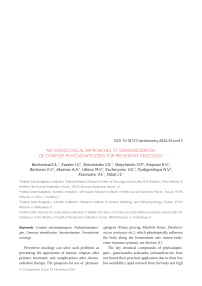Methodological approaches to standardization of complex phytoadaptogens for preventive oncology
Автор: Bocharova O.A., Kazeev I.V., Shevchenko V.G., Sheychenko O.P., Karpova R.V., Bocharov E.V., Aksenov A.A., Utkina M.V., Kucheryanu V.G., Pyatigorskaya N.V., Kosorukov V.S., Stilidi I.S.
Журнал: Cardiometry @cardiometry
Статья в выпуске: 33, 2024 года.
Бесплатный доступ
Preventive oncology can solve such problems as preventing the appearance of tumors, relapses after primary treatment, and complications after chemo-radiation therapy. The prospects for use of phytoadaptogens (Panax ginseng, Rhodiola Rosea, Eleutherococcus senticosus etc.), which pleiotropically influence the body along the homeostasis axis (neuro-endocrine-immune systems), are obvious.
Complex phytoadaptogens, multiphytoadaptogen, chemical identification, standardization, translational oncology
Короткий адрес: https://sciup.org/148329768
IDR: 148329768 | DOI: 10.18137/cardiometry.2024.33.conf.2
Текст статьи Methodological approaches to standardization of complex phytoadaptogens for preventive oncology
Preventive oncology can solve such problems as preventing the appearance of tumors, relapses after primary treatment, and complications after chemoradiation therapy. The prospects for use of phytoad- 12 | Cardiometry | Issue 33. November 2024
aptogens ( Panax ginseng , Rhodiola Rosea , Eleuthero-coccus senticosus etc.), which pleiotropically influence the body along the homeostasis axis (neuro-endo-crine-immune systems), are obvious [1].
The key chemical compounds of phytoadapto-gens - ginsenosides, aralosides, schisandrins etc. have not found their practical application due to their low bio-availability, rapid removal from the body and high toxicity. Therefore, the use of galenic drugs remains the preferable option. However, the long-term use thereof is limited by tolerance, i.e. loss of the effect produced on the body over time. The problem can be solved by using pharmaceutical compositions based on adapto-genic plants. Combination drugs, which incorporate structurally diverse biologically active substances, can make unique effects that cannot be obtained with any individual ingredient thereof. Moreover, complex phytoadaptogens correspond to the modern paradigm of creating promising drugs, switching from the “one target - one drug” model to a multi-target approach.
An important step in the translational approach to promoting pharmaceutical compositions from fundamental research to practical application is an identification of their chemical ingredients, standardization, quality control and authenticity.
Thus, determining the possibility of standardization and quality control of pharmaceutical compositions using a set of modern physicochemical and biological, as well as computer methods of analysis is considered to be an urgent task and refers to an important area of research in the field of translational medicine.
The aim of the study is to develop methodological approaches to standardization and justification of the biological activity of complex phytoadaptogens taking into account modern physicochemical, computer and biological methods of analysis.
Materials and methods . Physicochemical methods: nuclear magnetic resonance spectroscopy (NMR spectroscopy); UV spectrophotometry using differential electron spectra and shift reagents; gas chromatography-mass spectrometry (GC-MS); high-performance liquid chromatography coupled with UV and mass detectors (UV HPLC, HPLC MS/MS). The analysis of biological activity profiles and mechanisms of action of individual compounds was carried out in silico using the PASS2020 software. Synergistic/ad-ditive effects were analyzed with the Pharma Expert software. The biological method for determining the general adaptogenicity score (GAS) in vitro involves assessing the nature of the growth acceleration of the Saccharomyces cerevisiae (baker’s yeast) cell culture in an energy-poor medium in the presence of an adapto-gen. Our statistical analysis of the results was performed using the STATISTICA 10.0 software.
Results. The algorithm for analyzing the chemical composition and standardizing multicomponent phytoadaptogens was developed with a multiphyto-adaptogen (MPA) as an example. MPA is a pharmaceutical composition that includes components of forty-plant extracts, including adaptogens (Ginseng, Rhodiola rosea, Eleutherococcus, Aralia, Schisandra etc.). As a result of large-scale experimental and clinical studies, the following were revealed: neuroprotec-tive, hormonal and immunomodulatory (including adhesionogenic, interferonogenic and anti-inflammatory), antioxidant, antimutagenic, antitoxic, and radioprotective effects produced by MPA. The effectiveness of MPA for the prevention and treatment of cancer and aging diseases was demonstrated. The absence of tolerance and addiction to MPA, as against individual adaptogens, was detected [2-4].
The methodology of the study consisted in testing the list of phytoextracts and identifying major MPA compounds using a set of adequate physicochemical methods, evaluating the diversity of their pharmacological activity and the range of mechanisms of action with computer analysis, and showing the possibility of quantitative and qualitative control of the authenticity of the adaptogenic MPA drug with a biological method (see Fig. 1 herein) [5-9].
Physicochemical, computer and biological studies of adaptogenic phytocompositions can serve as methodological approaches to standardization, identification and quality control of phytoadaptogenic pharmaceutical compositions containing a structural diversity of chemical compounds, as well as the basis for developing regulatory documentation for the registration of drugs in terms of their routine control methods.
Conclusion . A combination of physical, chemical, computer and biological methods allows us to formulate an algorithm for standardization, identification and quality control of complex phytoadaptogens with a wide variety of structural compounds in their composition when developing non-toxic regulators for the effective prevention and treatment of neoplasms, age-related pathologies, as well as for improving the life quality, life expectancy and improvement of body functions under the conditions of multifactorial environmental impacts.


